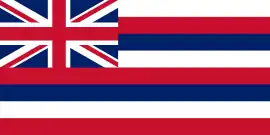This is a list of residences once occupied by Hawaiian royalty during the Kingdom of Hawaii. Few can be referred to as palaces; most were private residences used by the aliʻi nui.
Royal residences
| Residence | Location | Occupant | Current Status | Ref |
|---|---|---|---|---|
| ʻĀinahau | Honolulu | Kaʻiulani | Estate willed to the City of Honolulu for a park; the house burned down in early 1900s; the Sheraton Princess Kaiulani Hotel was built on the ground | [1] |
| Brick Palace | Lāhainā | Meant for Kaʻahumanu, but she had a grass hut built next to it and Kamehameha I lived in it for about a year. | Built by Mr. Mela [Miller] and Mr. Keka ‘ele’ele for Kaahumanu. Used by Kamehameha when he moved his court to this location. Converted into storage shed and later torn down; only the foundation and a memorial plaque remain | [2] |
| Haimoeipo | Honolulu | Queen Kalama, Victoria Kamāmalu, Lunalilo? | now site of the Hawaii State Capitol | [3] |
| Haleʻākala (ʻAikupika) | Honolulu | Bernice Pauahi Bishop & Liliʻuokalani | converted to the Arlington Hotel which was later torn down on October 1908 | [4] |
| Haleʻākala (Royal Bungalow) | Honolulu | Kalākaua, Queen Kapiʻolani | Bungalow build on the ground of ʻIolani Palace, also called King's House, Queen's House or Healani (same as the Boathouse) | [5] |
| Halekamani | Lāhainā | Nāhienaena | sold to Gorham D. Gilman; ? | [6] |
| Hale Kauila (Halekauwila) | Honolulu | Nāhienaena, Kamehameha IV, Queen Kalama | Built by Kīnaʻu for Nāhienaena during his fatal pregnancy; used as a residence and meeting place for Kamehameha III prior to 1845 | [7] |
| Hale Piula (or Halehuki) | Lāhainā | Kamehameha III | converted into courthouse after capital transferred to Honolulu, stones reused to construct new courthouse in 1858; part of Moku'ula site [8] | [9] |
| Hāliʻimaile | Honolulu, corner of King and Richards streets | Boki and Kuini Liliha, later Victoria Kamāmalu and Lot Kapuāiwa | ? | [10] |
| Hānaiakamalama (Queen Emma Summer Palace) | Nuʻuanu (2913 Pali Highway) | Queen Emma | converted into museum by the Daughters of Hawaii | [11] |
| Healani (Kalākaua's Boathouse) | Honolulu Harbor | Kalākaua | ? | [12] |
| Helumoa (Royal Groves) | Waikīkī | Kamehameha V | part of Bishop Estates; the royal cottage no longer exist; the Royal Hawaiian Center is on the spot but the royal coconut groves still remain | [13] |
| Hoʻihoʻikea | Honolulu | Kamehameha III, Kamehameha IV, Kamehameha V | Smaller royal residence flanking the west side of ʻIolani Palace on the west side. Named Hoʻihoʻikea (Restoration) in honor of Kamehameha III's restoration after the Paulet Affair of 1843.[14] | [15] |
| Honokaʻupu | Honolulu | Kekāuluohi, Charles Kanaʻina | Two-story coral house built for Kekāuluohi and her husband Charles Kanaʻina | [16] |
| Honuakaha | Honolulu | Queen Kapiolani | private residence of Queen Kapiolani near the corner of Queen and Punchbowl streets; ? | [17] |
| Huliheʻe Palace | Kailua-Kona | Keʻelikōlani | converted into museum by the Daughters of Hawaii in 1927 | [18] |
| Ihikapukalani and Kauluhinano | Honolulu | Kamehameha IV, Queen Emma, Albert Kamehameha | Smaller royal residence flanking the east side of ʻIolani Palace; the makai side was known as Kauluhinano, and the mauka side was known as Ihikapukalani; site of the Hawaii State Archive building[14] | [19] |
| ʻIolani Palace | Honolulu | Kamehameha III, Kamehameha IV, Kamehameha V, Lunalilo, Kalākaua, Liliʻuokalani | original palace torn down to make way for 2nd palace due to termite damage; after the overthrow the 2nd palace became the executive building of the Provisionial Government, the Republic, and the Territory of Hawaii; later converted and remodeled into a museum | [20] |
| Kamakahonu | Kailua-Kona | Kamehameha I | now part of the King Kamehameha's Kona Beach Hotel with the ʻAhuʻena Heiau restored | [21] |
| Kaniakapupu | Honolulu | Kamehameha III | Summer home in Nu`uanu at Luakaha Falls, adjacent to Kaniakapupu heiau of Lono. In ruins. | [22] |
| Keʻalohilani | Hamohamo, Waikīkī | Liliʻuokalani | Inherited from Liliʻuokalani's grandfather ʻAikanaka along with Paoakalani, reserved for her retainers | [23] |
| Keōua Hale | Honolulu (1302 Queen Emma Street) | Keʻelikōlani | originally called Kaʻakopua before it burned down in 1873, the 1883 building was converted into a grammar school; razed in 1926 due to termite damage; open as the Central Middle School in 1928 | [24] |
| Kīnaʻu Hale | Honolulu | Keoni Ana, later Kalama, Albert Kūnuiākea | converted into the chamberlain quarters in later years; used for the inauguration ceremony of King Kalākaua in 1874 | [25] |
| Marine Residence | Waikīkī | Lunalilo, later Queen Emma | part of Queen Emma's trust; now site of the International Market Place | [26] |
| Marine Residence | Kailua-Kona | Kamehameha IV | he declared his neutrality during the American Civil War from here; ? | [27] |
| Mokuʻula | Lāhainā | Kamehameha III | abandoned in the mid-1800s; converted into a baseball field; now an archaeological site managed by the Friends of Mokuʻula; plans to restore the island and lake of Mokuhinia | [28] |
| Muʻolaulani | Kapālama | Liliʻuokalani | now the site of the Liliuokalani Children's Center | [29] |
| Paoakalani | Hamohamo, Waikīkī | Liliʻuokalani | Inherited from Liliʻuokalani's grandfather ʻAikanaka along with Kealohilani | [30] |
| Papakanene and Mokuaikaua | Honolulu | Victoria Kamāmalu, Kekūanaōʻa | originally the residence of Kalanimoku, on the south side of the Honolulu Fort | [31] |
| Pualeilani | Waikīkī | Kalākaua, Queen Kapiʻolani, Jonah Kūhiō Kalanianaʻole | willed to the City of Honolulu by Prince Kūhiō; became the Kuhio Beach | [32] |
| Rooke House | Honolulu | Queen Emma | during the 1900s it was a kindergarten named Queen Emma Hall in honor of the last owner of the house. Later the site of Rooke House was occupied by the Liberty Theater (which closed in 1980) and is now a parking lot. | [33] |
| Ululani or Kēhaulani | Honolulu | Victoria Kinoiki Kekaulike | willed to be site of maternity home; now site of Kapiolani Medical Center for Women and Children | [34] |
| Waipiʻo Palace | Waipiʻo Valley | ancient Kings of Hawaii Island | destroyed by the King Kahekili II of Maui in the 1700s | [35] |
| Wānanakoa | Nuʻuanu | Bernice Pauahi Bishop | now the site of the Royal Mausoleum | [36] |
| Washington Place | Honolulu | Liliʻuokalani | used as the Governor's mansion; now a museum | [18] |
Gallery
.JPG.webp)
.jpg.webp) King Kalākaua's residence outside Iolani Palace before 1882
King Kalākaua's residence outside Iolani Palace before 1882 Hale Aliʻi, the first royal palace on the spot of the current ʻIolani Palace, in 1857.
Hale Aliʻi, the first royal palace on the spot of the current ʻIolani Palace, in 1857. ʻĀinahau, home of Kaʻiulani, in the 1890s, showing the newly built Western house
ʻĀinahau, home of Kaʻiulani, in the 1890s, showing the newly built Western house.jpg.webp) ʻĀinahau, home of Kaiʻulani, in the 1870s, showing the original family bungalow
ʻĀinahau, home of Kaiʻulani, in the 1870s, showing the original family bungalow Grasshut palace of King Kamehameha III in Honolulu, 1826
Grasshut palace of King Kamehameha III in Honolulu, 1826%252C_Honolulu%252C_Hawaii.JPG.webp) Hānaiakamālama, Queen Emma's Summer Palace in the Nuanuʻu Valley
Hānaiakamālama, Queen Emma's Summer Palace in the Nuanuʻu Valley Washington Place, Liliʻuokalani's private residence inherited from her husband John Owen Dominis
Washington Place, Liliʻuokalani's private residence inherited from her husband John Owen Dominis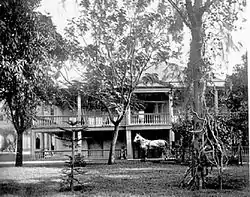 Rooke House, childhood home of Queen Emma
Rooke House, childhood home of Queen Emma.jpg.webp) Healani, King Kalākaua's Boathouse where he spend a majority of his reign and where he entertained Robert Louis Stevenson
Healani, King Kalākaua's Boathouse where he spend a majority of his reign and where he entertained Robert Louis Stevenson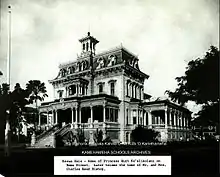 Keōua Hale, Keʻelikōlani's Honolulu residence which rivaled Kalakaua's Iolani Palace in size and granduer
Keōua Hale, Keʻelikōlani's Honolulu residence which rivaled Kalakaua's Iolani Palace in size and granduer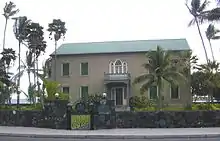 Huliheʻe Palace, Keʻelikōlani's residence in Kailua-Kona
Huliheʻe Palace, Keʻelikōlani's residence in Kailua-Kona Grasshut on the grounds of Huliheʻe Palace where Keʻelikōlani much preferred to reside in
Grasshut on the grounds of Huliheʻe Palace where Keʻelikōlani much preferred to reside in Heluma, King Kamehameha V's royal cottage amongst the sacred coconut groves
Heluma, King Kamehameha V's royal cottage amongst the sacred coconut groves The Bishop's Waikiki residence
The Bishop's Waikiki residence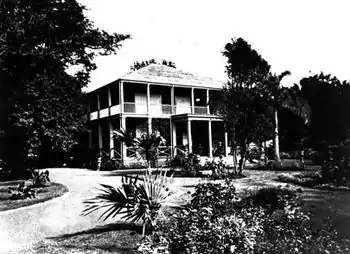 Residence built by Pākī for his family; Liliʻuokalani childhood home
Residence built by Pākī for his family; Liliʻuokalani childhood home Halekamani, Princess Nāhienaena's residence in Lāhainā
Halekamani, Princess Nāhienaena's residence in Lāhainā.jpg.webp) Hāliʻimaile, Princess Victoria Kamāmalu and Prince Lot Kapuāiwa's residence prior his accession as king
Hāliʻimaile, Princess Victoria Kamāmalu and Prince Lot Kapuāiwa's residence prior his accession as king One of Queen Liliʻuokalani's Waikīkī residence at Hamohamo
One of Queen Liliʻuokalani's Waikīkī residence at Hamohamo One of Liliʻuokalani’s residences, unidentified
One of Liliʻuokalani’s residences, unidentified Paoakalani, Queen Liliʻuokalani's Waikīkī residence at Hamohamo
Paoakalani, Queen Liliʻuokalani's Waikīkī residence at Hamohamo Mokuhinia the manmade lake upon which the island residence of Mokuʻula stood
Mokuhinia the manmade lake upon which the island residence of Mokuʻula stood Queen Emma's Waikīkī residence probably the Marine Residence of Lunalilo
Queen Emma's Waikīkī residence probably the Marine Residence of Lunalilo Queen Kapiʻolani's Waikīkī residence probably Pualeilani
Queen Kapiʻolani's Waikīkī residence probably Pualeilani Kamehameha V Cottage, now the Moanalua Gardens
Kamehameha V Cottage, now the Moanalua Gardens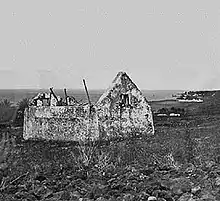 The ruins of John Young's house in Kawaihae where he raised his large family
The ruins of John Young's house in Kawaihae where he raised his large family Hale Kauila in Honolulu
Hale Kauila in Honolulu
References
- ↑ Kam 2022, pp. 58–74.
- ↑ Kam 2022, pp. 33–34.
- ↑ Kam 2022, pp. 114–116.
- ↑ Kam 2022, pp. 164–167.
- ↑ Kam 2022, pp. 119–120.
- ↑ Kam 2022, pp. 35–37.
- ↑ Kam 2022, pp. 148–150.
- ↑ "Hale Piula". 2001-03-01. Archived from the original on 2001-03-01. Retrieved 2021-08-30.
- ↑ Kam 2022, pp. 40–41.
- ↑ Kam 2022, pp. 102–105.
- ↑ Kam 2022, pp. 5.
- ↑ Kam 2022, pp. 182–184.
- ↑ Kam 2022, pp. 55–58.
- 1 2 Judd 1975, p. 67.
- ↑ Kam 2022, pp. 105–106.
- ↑ Kam 2022, pp. 99–102.
- ↑ Kam 2022, pp. 179–182.
- 1 2 Kam 2022, p. 4.
- ↑ Kam 2022, pp. 67–108.
- ↑ Kam 2022, pp. 92–99.
- ↑ Kam 2022, pp. 14–18.
- ↑ Kam 2022, pp. 158–164.
- ↑ Kam 2022, pp. 82–84.
- ↑ Kam 2022, pp. 193–198.
- ↑ Kam 2022, p. 99.
- ↑ Kam 2022, pp. 74–77.
- ↑ Kam 2022, pp. 29–30.
- ↑ Kam 2022, pp. 38–40.
- ↑ Kam 2022, pp. 204–214.
- ↑ Kam 2022, pp. 87–91.
- ↑ Kam 2022, pp. 168–171.
- ↑ Kam 2022, pp. 77–87.
- ↑ Kam 2022, pp. 150–158.
- ↑ Kam 2022, pp. 198–200.
- ↑ Fornander 1880, p. 243.
- ↑ Kanahele 2002, p. 74.
Bibliography
- Fornander, Abraham (1880). Stokes, John F. G. (ed.). An Account of the Polynesian Race: Its Origins and Migrations, and the Ancient History of the Hawaiian People to the Times of Kamehameha I. Vol. 2. London: Trubner & Company. OCLC 4823096. Archived from the original on June 29, 2016. Retrieved February 29, 2020.
- Judd, Walter F. (1975). Palaces and Forts of the Hawaiian Kingdom: From Thatch to American Florentine. Palo Alto, CA: Pacific Books, Publishers. ISBN 978-0-87015-216-0. OCLC 2073825.
- Kam, Ralph Thomas (2022). Lost Palaces of Hawaiʻi Royal Residences of the Kingdom Period. S. I.: McFarland, Incorporated, Publishers. ISBN 978-1-4766-8811-4. OCLC 1264273188.
- Kanahele, George S. (2002) [1986]. Pauahi: The Kamehameha Legacy. Honolulu: Kamehameha Schools Press. ISBN 978-0-87336-005-0. OCLC 173653971.
Further reading
- Taylor, Albert Pierce (1927). The Rulers of Hawaii, The Chiefs and Chiefesses, Their Palaces, Monuments, Portraits and Tombs. Honolulu: Advertiser Publishing Company. OCLC 9380797.
- Williams, Riánna M. (2015). Queen Liliʻuokalani, the Dominis Family, and Washington Place, their home. Honolulu: Ka Mea Kakau Press. ISBN 978-0-692-37922-6. OCLC 927784027.
- Winne, Jane Lathrop (1928). Kuakini and Hulihee: the Story of the Kailua Palace, Kona, Hawaii. Honolulu. OCLC 16333276.
{{cite book}}: CS1 maint: location missing publisher (link)
External links
Wikimedia Commons has media related to Royal residences in the Kingdom of Hawaii.
This article is issued from Wikipedia. The text is licensed under Creative Commons - Attribution - Sharealike. Additional terms may apply for the media files.
